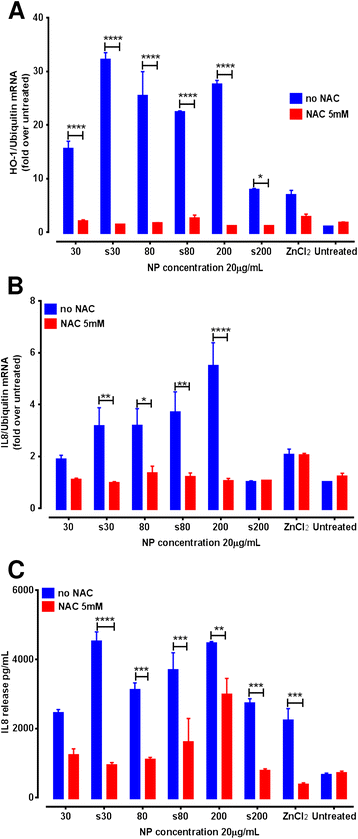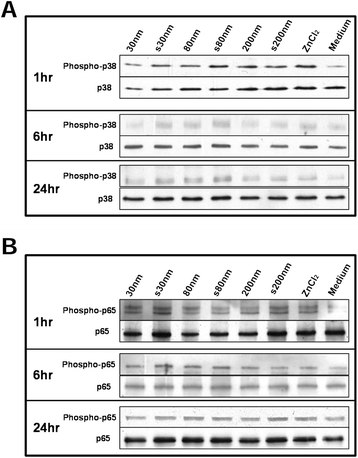Investigating the immunomodulatory nature of zinc oxide nanoparticles at sub-cytotoxic levels in vitro and after intranasal instillation in vivo
- PMID: 25645871
- PMCID: PMC4324663
- DOI: 10.1186/s12951-015-0067-7
Investigating the immunomodulatory nature of zinc oxide nanoparticles at sub-cytotoxic levels in vitro and after intranasal instillation in vivo
Abstract
Background: This study evaluates the time-dependent pro-inflammatory response of the model human lung epithelial cells (A549) to industrially relevant zinc oxide nanoparticles (ZnO NPs). In terms of toxicity, ZnO-NPs are categorised into the group of high toxicity nanomaterials. However information on pro-inflammatory potential of these NPs at sub-toxic concentrations is limited. Understanding how cellular defense mechanisms function in the presence of sub-cytotoxic concentrations of these NPs is vital. Moreover, there is an urgent need for additional in vivo studies addressing pulmonary toxicity due to accidental inhalation of ZnO NPs.
Results: Exposure to sub-cytotoxic ZnO NP concentrations (20 μg/mL) induced significant up-regulation of mRNA for the pro-inflammatory cytokine IL-8 and redox stress marker heme oxygenase-1, along with increased release of IL-8. The highest pro-inflammatory response was recorded after 4 to 6 hr exposure to ZnO NPs over a 24 hr period. Pre-treatment of A549 cells with the sulfhydryl antioxidant N-acetyl cysteine (at 5 mM) resulted in significant reduction of the up-regulation of inflammatory markers, confirming the role of reactive oxygen species in the observed immunomodulatory effects, independent of cytotoxicity. Furthermore, we report for the first time that, intranasal instillation of a single dose (5 mg/kg) of pristine or surfactant-dispersed ZnO NPs can cause pulmonary inflammation, already after 24 hr in a murine model. This was confirmed by up-regulation of eotaxin mRNA in the lung tissue and release of pro-inflammatory cytokines in the sera of mice exposed to ZnO NPs.
Conclusion: Our study highlights that even at sub-cytotoxic doses ZnO NPs can stimulate a strong inflammatory and antioxidant response in A549 cells. ZnO NP mediated cytotoxicity may be the outcome of failure of cellular redox machinery to contain excessive ROS formation. Moreover exposure to a single but relatively high dose of ZnO NPs via intranasal instillation may provoke acute pulmonary inflammatory reactions in vivo.
Figures






Similar articles
-
ZnO nanoparticles induced inflammatory response and genotoxicity in human blood cells: A mechanistic approach.Food Chem Toxicol. 2015 Nov;85:61-70. doi: 10.1016/j.fct.2015.06.018. Epub 2015 Jul 2. Food Chem Toxicol. 2015. PMID: 26146191
-
Reactive oxygen species trigger NF-κB-mediated NLRP3 inflammasome activation induced by zinc oxide nanoparticles in A549 cells.Toxicol Ind Health. 2017 Oct;33(10):737-745. doi: 10.1177/0748233717712409. Epub 2017 Sep 5. Toxicol Ind Health. 2017. PMID: 28870124
-
Irradiation-Enhanced Cytotoxicity of Zinc Oxide Nanoparticles.Int J Toxicol. 2014 May;33(3):187-203. doi: 10.1177/1091581814529168. Epub 2014 Apr 3. Int J Toxicol. 2014. PMID: 24700570
-
The toxicology of ion-shedding zinc oxide nanoparticles.Crit Rev Toxicol. 2016;46(4):348-84. doi: 10.3109/10408444.2015.1137864. Epub 2016 Feb 25. Crit Rev Toxicol. 2016. PMID: 26963861 Review.
-
Impact of labile metal nanoparticles on cellular homeostasis. Current developments in imaging, synthesis and applications.Biochim Biophys Acta Gen Subj. 2017 Jun;1861(6):1566-1577. doi: 10.1016/j.bbagen.2016.12.012. Epub 2016 Dec 16. Biochim Biophys Acta Gen Subj. 2017. PMID: 27993661 Review.
Cited by
-
Neuroinflammation is induced by tongue-instilled ZnO nanoparticles via the Ca2+-dependent NF-κB and MAPK pathways.Part Fibre Toxicol. 2018 Oct 19;15(1):39. doi: 10.1186/s12989-018-0274-0. Part Fibre Toxicol. 2018. PMID: 30340606 Free PMC article.
-
A Comparative In Vivo Scrutiny of Biosynthesized Copper and Zinc Oxide Nanoparticles by Intraperitoneal and Intravenous Administration Routes in Rats.Nanoscale Res Lett. 2018 Apr 3;13(1):93. doi: 10.1186/s11671-018-2497-2. Nanoscale Res Lett. 2018. PMID: 29616363 Free PMC article.
-
An Integrated, High-Throughput Strategy for Multiomic Systems Level Analysis.J Proteome Res. 2018 Oct 5;17(10):3396-3408. doi: 10.1021/acs.jproteome.8b00302. Epub 2018 Aug 30. J Proteome Res. 2018. PMID: 30114907 Free PMC article.
-
Inhalation of ZnO Nanoparticles: Splice Junction Expression and Alternative Splicing in Mice.Toxicol Sci. 2019 Mar 1;168(1):190-200. doi: 10.1093/toxsci/kfy288. Toxicol Sci. 2019. PMID: 30500950 Free PMC article.
-
Serum zinc level is associated with liver dysfunction caused by white smoke inhalation.Gastroenterol Rep (Oxf). 2018 Nov;6(4):304-307. doi: 10.1093/gastro/goy008. Epub 2018 Mar 7. Gastroenterol Rep (Oxf). 2018. PMID: 30430020 Free PMC article.
References
-
- Wang ZL. Zinc oxide nanostructures: growth, properties and applications. J Phys Condens Matter. 2004;16:R829–58. doi: 10.1088/0953-8984/16/25/R01. - DOI
-
- Lin W, Xu Y, Huang C-C, Ma Y, Shannon K, Chen D-R, et al. Toxicity of nano- and micro-sized ZnO particles in human lung epithelial cells. J Nanoparticle Res. 2009;11:25–39. doi: 10.1007/s11051-008-9419-7. - DOI
Publication types
MeSH terms
Substances
LinkOut - more resources
Full Text Sources
Other Literature Sources
Miscellaneous

